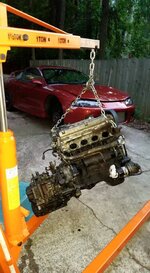patkelley
Probationary Member
- 15
- 0
- Aug 10, 2013
-
Marietta,
Georgia
I have a 97 GSX with a genuine mhi big 16G turbo, 850 cc inj, FMIC, 3"TBE, intake, HKS 272s, and 99 black box ecu tuned via ecuflash/ceddy mods. My question is this - this car has roughly double the exhaust flow (i.e. amount of gas exiting the pipe) than either of my Evo's (06 MR and 2010 SE, both with similar mods) at idle. I can also hear the turbo spinning thru the intake filter at idle, which again doesn't happen with the Evo's. I am having some issues with this car, mainly off-idle stumble (which may be related). I wonder if I have a head/HG issue resulting in excessive exhaust flow/pressure, and am curious if anyone else is seeing what seems like huge idle airflow in their car at reasonable rpm, ~800 rpm.

















